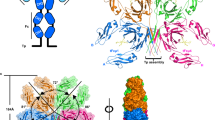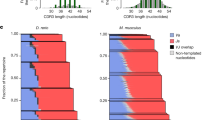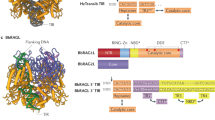Abstract
Although the origins of genes encoding the rearranging binding receptors remain obscure, it is predicted that their ancestral forms were nonrearranging immunoglobulin-type domains. Variable region–containing chitin-binding proteins (VCBPs) are diversified immune-type molecules found in amphioxus (Branchiostoma floridae), an invertebrate that diverged early in deuterostome phylogeny. To study the potential evolutionary relationships between VCBPs and vertebrate adaptive immune receptors, we solved the structures of both a single V-type domain (to 1.15 Å) and a pair of V-type domains (to 1.85 Å) from VCBP3. The deduced structures show integral features of the ancestral variable-region fold as well as unique features of variable-region pairing in molecules that may reflect characteristics of ancestral forms of diversified immune receptors found in modern-day vertebrates.
This is a preview of subscription content, access via your institution
Access options
Subscribe to this journal
Receive 12 print issues and online access
$209.00 per year
only $17.42 per issue
Buy this article
- Purchase on Springer Link
- Instant access to full article PDF
Prices may be subject to local taxes which are calculated during checkout






Similar content being viewed by others
References
Orengo, C.A. & Thornton, J.M. Protein families and their evolution—a structural perspective. Annu. Rev. Biochem. 74, 867–900 (2005).
Bork, P., Holm, L. & Sander, C. The immunoglobulin fold. Structural classification, sequence patterns and common core. J. Mol. Biol. 242, 309–320 (1994).
Barclay, A.N. Membrane proteins with immunoglobulin-like domains–a master superfamily of interaction molecules. Semin. Immunol. 15, 215–223 (2003).
Hunkapiller, T. & Hood, L. Diversity of the immunoglobulin gene superfamily. Adv. Immunol. 44, 1–62 (1989).
Eason, D.D. et al. Mechanisms of antigen receptor evolution. Semin. Immunol. 16, 215–226 (2004).
Chothia, C., Gelfand, I. & Kister, A. Structural determinants in the sequences of immunoglobulin variable domains. J. Mol. Biol. 278, 457–479 (1998).
Garrett, T.P., Wang, J., Yan, Y., Liu, J. & Harrison, S.C. Refinement and analysis of the structure of the first two domains of human CD4. J. Mol. Biol. 234, 763–778 (1993).
Leahy, D.J., Axel, R. & Hendrickson, W.A. Crystal structure of a soluble form of the human T cell coreceptor CD8 at 2.6 Å resolution. Cell 68, 1145–1162 (1992).
Cantoni, C. et al. The three-dimensional structure of the human NK cell receptor NKp44, a triggering partner in natural cytotoxicity. Structure (Camb.) 11, 725–734 (2003).
Laird, D.J., De Tomaso, A.W., Cooper, M.D. & Weissman, I.L. 50 million years of chordate evolution: seeking the origins of adaptive immunity. Proc. Natl. Acad. Sci. USA 97, 6924–6926 (2000).
Litman, G.W., Cannon, J.P. & Dishaw, L.J. Reconstructing immune phylogeny: new perspectives. Nat. Rev. Immunol. 5, 866–879 (2005).
Desmyter, A. et al. Crystal structure of a camel single-domain VH antibody fragment in complex with lysozyme. Nat. Struct. Biol. 3, 803–811 (1996).
Stanfield, R.L., Dooley, H., Flajnik, M.F. & Wilson, I.A. Crystal structure of a shark single-domain antibody V region in complex with lysozyme. Science 305, 1770–1773 (2004).
Garcia, K.C. et al. Structural basis of plasticity in T cell receptor recognition of a self peptide-MHC antigen. Science 279, 1166–1172 (1998).
Cannon, J.P., Haire, R.N. & Litman, G.W. Identification of diversified genes that contain immunoglobulin-like variable regions in a protochordate. Nat. Immunol. 3, 1200–1207 (2002).
Cannon, J.P., Haire, R.N., Schnitker, N., Mueller, M.G. & Litman, G.W. Individual protochordates possess unique immune-type receptor repertoires. Curr. Biol. 14, R465–R466 (2004).
Davis, M.M. & Bjorkman, P.J. T-cell antigen receptor genes and T-cell recognition. Nature 334, 395–402 (1988).
Medzhitov, R. & Janeway, C.A., Jr Advances in immunology: innate immunity. N. Engl. J. Med. 343, 338–344 (2000).
Zhang, S-M., Adema, C.M., Kepler, T.B. & Loker, E.S. Diversification of Ig superfamily genes in an invertebrate. Science 305, 251–254 (2004).
Watson, F.L. et al. Extensive diversity of Ig-superfamily proteins in the immune system of insects. Science 309, 1874–1878 (2005).
Wang, J.W. et al. SAD phasing by combination of direct methods with the SOLVE/RESOLVE procedure. Acta Crystallogr. D Biol. Crystallogr. 60, 1244–1253 (2004).
Schneider, T.R. & Sheldrick, G.M. Substructure solution with SHELXD. Acta Crystallogr. D Biol. Crystallogr. 58, 1772–1779 (2002).
Carter, P., Andersen, C.A. & Rost, B. DSSPcont: Continuous secondary structure assignments for proteins. Nucl. Acids Res. 31, 3293–3295 (2003).
Holm, L. & Sander, C. Protein folds and families: sequence and structure alignments. Nucl. Acids Res. 27, 244–247 (1999).
Dauter, Z., Lamzin, V.S. & Wilson, K.S. The benefits of atomic resolution. Curr. Opin. Struct. Biol. 7, 681–688 (1997).
Babu, M.M. NCI: A server to identify non-canonical interactions in protein structures. Nucl. Acids Res. 31, 3345–3348 (2003).
Kolodny, R., Koehl, P. & Levitt, M. Comprehensive evaluation of protein structure alignment methods: scoring by geometric measures. J. Mol. Biol. 346, 1173–1188 (2005).
Li, H. et al. Structure of the Vδ domain of a human γδ T-cell antigen receptor. Nature 391, 502–506 (1998).
Clements, C.S. et al. The crystal structure of myelin oligodendrocyte glycoprotein, a key autoantigen in multiple sclerosis. Proc. Natl. Acad. Sci. USA 100, 11059–11064 (2003).
van Raaij, M.J., Chouin, E., van der Zandt, H., Bergelson, J.M. & Cusack, S. Dimeric structure of the coxsackievirus and adenovirus receptor D1 domain at 1.7 Å resolution. Structure 8, 1147–1155 (2000).
Ostrov, D.A., Shi, W., Schwartz, J.C., Almo, S.C. & Nathenson, S.G. Structure of murine CTLA-4 and its role in modulating T cell responsiveness. Science 290, 816–819 (2000).
Kaufman, J. The origins of the adaptive immune system: whatever next? Nat. Immunol. 3, 1124–1125 (2002).
Rudolph, M.G., Luz, J.G. & Wilson, I.A. Structural and thermodynamic correlates of T cell signaling. Annu. Rev. Biophys. Biomol. Struct. 31, 121–149 (2002).
Luz, J.G. et al. Structural comparison of allogeneic and syngeneic T cell receptor-peptide-major histocompatibility complex complexes: a buried alloreactive mutation subtly alters peptide presentation substantially increasing V(β) Interactions. J. Exp. Med. 195, 1175–1186 (2002).
Lo Conte, L., Chothia, C. & Janin, J. The atomic structure of protein-protein recognition sites. J. Mol. Biol. 285, 2177–2198 (1999).
Suzuki, T., Shin, I., Fujiyama, A., Kohara, Y. & Kasahara, M. Hagfish leukocytes express a paired receptor family with a variable domain resembling those of antigen receptors. J. Immunol. 174, 2885–2891 (2005).
Haruta, C., Suzuki, T. & Kasahara, M. Variable domains in hagfish: NICIR is a polymorphic multigene family expressed preferentially in leukocytes and is related to lamprey TCR-like. Immunogenetics 58, 216–225 (2006).
Seeger, M.A. & Kaufman, T.C. Characterization of amalgam: a member of the immunoglobulin superfamily from Drosophila. Cell 55, 589–600 (1988).
Streltsov, V.A. et al. Structural evidence for evolution of shark Ig new antigen receptor variable domain antibodies from a cell-surface receptor. Proc. Nat. Acad. Sci. USA 101, 12444–12449 (2004).
Cannon, J.P., Haire, R.N., Rast, J.P. & Litman, G.W. The phylogenetic origins of the antigen binding receptors and somatic diversification mechanisms. Immunol. Rev. 200, 12–22 (2004).
Raskin, D.M., Seshadri, R., Pukatzki, S.U. & Mekalanos, J.J. Bacterial genomics and pathogen evolution. Cell 124, 703–714 (2006).
Chatterji, M., Tsai, C.L. & Schatz, D.G. New concepts in the regulation of an ancient reaction: transposition by RAG1/RAG2. Immunol. Rev. 200, 261–271 (2004).
Fugmann, S.D., Messier, C., Novack, L.A., Cameron, R.A. & Rast, J.P. An ancient evolutionary origin of the Rag1/2 gene locus. Proc. Natl. Acad. Sci. USA 103, 3728–3733 (2006).
Delsuc, F., Brinkmann, H., Chourrout, D. & Philippe, H. Tunicates and not cephalochordates are the closest living relatives of vertebrates. Nature 439, 965–968 (2006).
Hernandez Prada, J.A., Haire, R.N., Cannon, J.P., Litman, G.W. & Ostrov, D.A. Crystallization and preliminary x-ray analysis of VCBP3 from Branchiostoma floridae. Acta Crystallogr. D Biol. Crystallogr. 60, 2022–2024 (2004).
Weeks, C.M. et al. Automatic solution of heavy-atom substructures. Methods Enzymol. 374, 37–83 (2003).
Otwinowski, Z. & Minor, W. Processing of X-ray diffraction data collected in oscillation mode. Methods Enzymol. 276, 307–326 (1997).
Kantardjieff, K.A. & Rupp, B. Matthews coefficient probabilities: Improved estimates for unit cell contents of proteins, DNA, and protein-nucleic acid complex crystals. Protein Sci. 12, 1865–1871 (2003).
Terwilliger, T.C. & Berendzen, J. Automated MAD and MIR structure solution. Acta Crystallogr. D Biol. Crystallogr. 55, 849–861 (1999).
Jones, T.A., Zou, J.Y., Cowan, S.W. & Kjeldgaard Improved methods for building protein models in electron density maps and the location of errors in these models. Acta Crystallogr. A. 47, 110–119 (1991).
Brunger, A.T. et al. Crystallography & NMR system: A new software suite for macromolecular structure determination. Acta Crystallogr. D Biol. Crystallogr. 54, 905–921 (1998).
Laskowski, R.A., Moss, D.S. & Thornton, J.M. Main-chain bond lengths and bond angles in protein structures. J. Mol. Biol. 231, 1049–1067 (1993).
McRee, D.E. XtalView/Xfit–A versatile program for manipulating atomic coordinates and electron density. J. Struct. Biol. 125, 156–165 (1999).
Emsley, P. & Cowtan, K. Coot: model-building tools for molecular graphics. Acta Crystallogr. D Biol. Crystallogr. 60, 2126–2132 (2004).
Lefranc, M.P. et al. IMGT-ONTOLOGY for immunogenetics and immunoinformatics. In Silico Biol. 4, 17–29 (2004).
Acknowledgements
We thank B. Pryor for editorial assistance. Supported by the National Institutes of Health (R01 AI23338 to G.W.L. and R01 DE013883 and R21 HL080222 to D.A.O.), the Cure Autism Now Foundation (2908051-12 to D.A.O.), the US Department of Energy (DE-AC02-98CH10886 for beamline X6A) and the National Institutes of Health, National Institute of General Medical Sciences (GM-0080 for beamline X6A).
Author information
Authors and Affiliations
Contributions
J.A.H.P., crystallization, data collection, data reduction, structure determination, structural refinement, structural analysis and composition of the manuscript; R.N.H., protein expression, refolding and purification of recombinant V1 and V1-V2 VCBPs and contributions to the manuscript; M.A., space-group determination and phase determination and cryoprotection of native and selenomethionine crystals for the high-resolution structure of VCBP3 V1 (1XT5); J.J., data collection, space-group determination and phase determination of native and selenomethionine crystals of VCBP3 V1V2 (2FBO); V.S., data collection supervision and mounting of native and selenomethionine crystals of VCBP3 V1(1XT5) and V1V2 (2FBO); J.P.C., generation of constructs for VCBP3 V1 and VCBP3 V1V2 expression and contributions to the manuscript; G.W.L., data analysis, interpretation, discussions and fundamental contributions to the manuscript; D.A.O., crystal mounting, cryoprotection, supervision of MAD and native data collection of VCBP3 V1 and SAD and native collection of VCBP3 V1V2 (2FBO) and fundamental contributions to the manuscript.
Corresponding authors
Ethics declarations
Competing interests
The authors declare no competing financial interests.
Supplementary information
Supplementary Table 1
Data collection and reduction statistics for VCBP3 crystals. (PDF 65 kb)
Supplementary Table 2
Refinement statistics for VCBP3 crystal structures. (PDF 60 kb)
Rights and permissions
About this article
Cite this article
Prada, J., Haire, R., Allaire, M. et al. Ancient evolutionary origin of diversified variable regions demonstrated by crystal structures of an immune-type receptor in amphioxus. Nat Immunol 7, 875–882 (2006). https://doi.org/10.1038/ni1359
Received:
Accepted:
Published:
Issue Date:
DOI: https://doi.org/10.1038/ni1359
This article is cited by
-
Secreted immunoglobulin domain effector molecules of invertebrates and management of gut microbial ecology
Immunogenetics (2022)
-
Immunoglobulin-like receptors and the generation of innate immune memory
Immunogenetics (2022)
-
Gut immunity in a protochordate involves a secreted immunoglobulin-type mediator binding host chitin and bacteria
Nature Communications (2016)
-
Structure of a variable lymphocyte receptor-like protein from the amphioxus Branchiostoma floridae
Scientific Reports (2016)
-
The origins of vertebrate adaptive immunity
Nature Reviews Immunology (2010)



